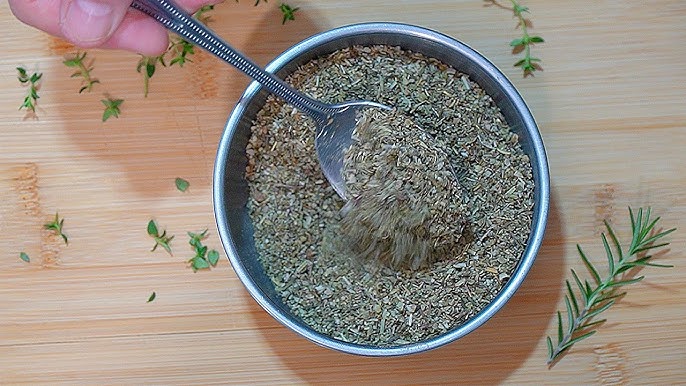Poultry Seasoning Recipe: Poultry seasoning is a timeless blend of herbs and spices, carefully crafted to enhance the flavor of poultry dishes like chicken, turkey, and even stuffing. But don’t let the name fool you—this savory mix is so versatile, you’ll find yourself sprinkling it on more than just bird.
Now, why go the homemade route when it’s just a few bucks at the store? Simple. When you make your own poultry seasoning, you control everything: flavor intensity, freshness, and even the ingredients themselves. Say goodbye to weird preservatives and hello to pure herbal magic. Plus, if you’ve ever had a store-bought mix that tasted like dust—yeah, this is your redemption arc.
Whether you’re prepping for Thanksgiving or just whipping up a midweek roast, this guide will walk you through making your own flavorful poultry seasoning from scratch. It’s easier than you think and way more rewarding.
Common Uses of Poultry Seasoning
Think poultry seasoning is only for roasted turkey? Think again. This blend is your culinary BFF when it comes to:
- Roasted chicken or turkey – the classic.
- Stuffing and dressing – gives that holiday vibe all year long.
- Gravy and sauces – adds depth with just a pinch.
- Vegetable sautés – especially root veggies.
- Soups and broths – like chicken noodle or creamy turkey.
- Meat substitutes – tofu, tempeh, or jackfruit benefit from the flavor boost.
And yes, it’s not just for holiday meals. Try it in a grilled sandwich or to season scrambled eggs. You’ll be shocked how well it complements so many dishes. That’s the magic of a good herb blend—it fits right in, whether it’s Sunday dinner or a lazy Tuesday night.
Benefits of Homemade Poultry Seasoning
Making poultry seasoning at home is like having a tailor-made suit—it just fits better. Here’s why it’s worth your time:
- Freshness: Store-bought jars can sit on shelves for months, sometimes years. Homemade means using freshly dried herbs or grinding fresh ones, boosting flavor by a mile.
- Customization: Hate sage? Leave it out. Love thyme? Double it. You can tweak the ratios or even add your own signature ingredients like lemon zest or chili flakes.
- No Fillers or Preservatives: Many pre-made spice blends sneak in salt, sugar, anti-caking agents, or artificial flavors. Your homemade version? Pure herbs.
- Budget-Friendly: Buying herbs in bulk or using what’s already in your pantry can save you money in the long run.
- Diet Control: Watching your sodium or trying to go gluten-free? This DIY mix gives you full control.
Bottom line: homemade poultry seasoning is more flavorful, adaptable, and just straight-up better. Once you try it, there’s no going back.
Essential Ingredients in Poultry Seasoning
Here’s the real deal—you only need a few key herbs to make a classic poultry seasoning. These ingredients all play a crucial role in crafting that familiar, warm, savory flavor.
Sage
Sage is the star of the show. Earthy, slightly peppery, and aromatic, it’s what gives poultry seasoning its distinctly nostalgic aroma—think Thanksgiving stuffing and roasted turkey. Dried sage is best, but make sure it’s vibrant and not grayish or flavorless.
Thyme
Thyme brings a slight lemony brightness that balances the heaviness of sage. It’s subtle but super important for adding complexity to your blend. Don’t skip it.
Marjoram
This underrated herb adds a soft, almost sweet note that rounds out the seasoning. It’s a cousin of oregano but more delicate, making it a great team player.
Rosemary
Piney and fragrant, rosemary gives your seasoning backbone and boldness. Use it sparingly, though—it’s potent and can dominate the mix if you’re not careful.
Nutmeg and Black Pepper (Optional Twists)
Nutmeg might seem out of place, but just a pinch can add depth and a cozy warmth, especially in stuffing or gravy. Black pepper brings a touch of heat that cuts through the richness of roasted meats.
Stay tuned for the next part, where we’ll cover the tools you need and walk through the actual recipe.
Equipment You’ll Need
Before you dive into mixing and grinding, make sure you’ve got the right tools. While the ingredients are the stars, the equipment plays a big supporting role in bringing your poultry seasoning together perfectly.
- Spice Grinder or Mortar and Pestle: To ensure all herbs are blended to a uniform texture, a spice grinder is your best friend. It gives you a smooth, fine powder. Don’t have one? No worries—a classic mortar and pestle works just fine, especially if you’re going for a rustic texture.
- Measuring Spoons: Precision matters here. Even though it’s a forgiving recipe, the right proportions bring balance to the blend.
- Airtight Jar or Container: Once you’ve made your mix, you’ll want to store it properly to keep the flavor intact. A small glass spice jar or any airtight container will do the trick. Bonus points if it’s labeled!
- Small Funnel (Optional): If you’re transferring your blend into a narrow spice jar, a funnel makes the job mess-free and easy.
This setup is super simple—no need to overcomplicate it. With just a few basic tools, you’ll be able to whip up a seasoning blend that tastes like it came from a gourmet kitchen.
Step-by-Step Poultry Seasoning Recipe
Let’s get to the heart of it—making your poultry seasoning from scratch. This process is quick, straightforward, and oh-so-satisfying.
Step 1: Gather Your Ingredients
Here’s a classic poultry seasoning blend to start with:
- 2 tablespoons dried sage
- 1 ½ tablespoons dried thyme
- 1 tablespoon marjoram
- 1 tablespoon rosemary
- 1 teaspoon ground black pepper
- ½ teaspoon ground nutmeg (optional)
Make sure all herbs are dried and preferably crushed or flaked—not whole leaves. If they’ve been sitting in your pantry for more than a year, consider replacing them. Freshness is key!
Pro tip: You can grow these herbs in your garden, dry them yourself, and have a never-ending supply of farm-fresh flavor. It doesn’t get more homemade than that.
Step 2: Measure Properly
Stick to the recipe proportions unless you’re adjusting for personal taste. Too much rosemary? It’ll overpower the blend. Too little sage? It won’t feel like poultry seasoning anymore.
Use level measuring spoons to avoid throwing off the balance. If you’re doubling or tripling the recipe, just multiply everything consistently.
Step 3: Grind for Even Texture
This is where the magic happens. Toss your measured herbs into a spice grinder and pulse a few times until you have a fine, uniform powder. If you’re using a mortar and pestle, crush in small batches until the texture is consistent.
Why grind it? Even texture ensures even distribution on meats and in recipes. Plus, it helps the flavors blend seamlessly into one another. You want each sprinkle to pack a punch.
Step 4: Mix Thoroughly
Once everything is ground, give it a good mix. You can do this right in the grinder or in a small bowl. Stir with a clean spoon to ensure every herb is evenly distributed.
If you’re going for a chunkier texture, skip the grinding and just mix the dried herbs as they are. It’ll look more rustic and work better for stuffing or slow roasts.
Step 5: Store Correctly
Transfer your blend into a clean, dry, airtight jar. Store it in a cool, dark place like a spice drawer or cupboard—not above the stove where heat and steam can degrade it.
Label it with the name and date—you’ll thank yourself later. Homemade poultry seasoning can stay fresh for up to 6 months, though you’ll likely use it up faster once you get a taste of how good it is.
Tips for Best Flavor
Want to take your poultry seasoning to the next level? Here are some expert tips to level up your blend:
- Use freshly dried herbs: If you’re drying herbs at home, make sure they’re completely dry before grinding to avoid clumping or mold.
- Toast before grinding: Lightly toasting the herbs in a dry pan for 1–2 minutes can intensify their aroma and flavor. Just don’t burn them!
- Experiment with ratios: Love rosemary? Increase it slightly. Want a warmer tone? Add a dash more nutmeg. Just be sure to adjust in small increments.
- Add lemon zest or garlic powder: These can introduce a new dimension to your seasoning, especially for summer grilling.
- Make it salt-free: Most homemade versions skip the salt, which is great if you’re watching your sodium or want full control during cooking.
Poultry Seasoning Variations
One of the best things about making your own poultry seasoning is the freedom to customize it. While the classic blend is perfect for traditional dishes, sometimes you want to mix things up. Here are a few creative variations that’ll give your recipes a flavorful twist:
1. Spicy Poultry Blend
Craving a bit of heat? Add a kick to your seasoning by mixing in:
- ½ teaspoon cayenne pepper
- 1 teaspoon paprika (smoked or sweet)
- Optional: crushed red pepper flakes
This version is perfect for grilled or roasted chicken when you want something bolder and spicier than your grandma’s Thanksgiving stuffing.
2. Mediterranean Twist
Want to infuse your dish with Mediterranean flair? Add these to the base mix:
- 1 teaspoon dried basil
- 1 teaspoon dried oregano
- ½ teaspoon lemon zest (dried)
This version pairs beautifully with roasted vegetables, lemon chicken, and even lamb. It gives your food a light, fresh aroma while keeping that comforting herbal base.
3. Herbaceous and Lemony
For a lighter, fresher vibe ideal for spring or summer, try this refreshing version:
- 1 teaspoon lemon thyme (or add lemon zest to regular thyme)
- ½ teaspoon dried parsley
- ½ teaspoon garlic powder
This blend is ideal for grilling chicken breasts or seasoning a light soup. It adds brightness without being overpowering.
Each of these variations brings a unique flavor profile to the table, and once you experiment, you might find your new go-to blend. That’s the beauty of homemade—total freedom to explore and tailor your seasoning to match your mood or meal.
Storing and Shelf Life
Storing your poultry seasoning properly is crucial if you want to keep it flavorful and aromatic. Herbs can lose their potency over time, especially when exposed to light, air, or moisture.
Storage Tips:
- Use an airtight container: Glass spice jars with tight lids are best. Avoid plastic containers if possible, as they can absorb and alter the scent over time.
- Keep it in a cool, dark place: A spice rack inside a cupboard or drawer works well. Avoid storing near your stove or in direct sunlight.
- Avoid moisture: Always use a dry spoon when scooping out the seasoning.
How Long Does It Last?
Homemade poultry seasoning typically lasts 4 to 6 months before it starts losing its potency. It won’t necessarily go bad, but the flavors will fade. You can still use it after that period, but you might need to use a bit more.
Signs It’s No Longer Fresh:
- The color has dulled significantly.
- The scent is weak or musty.
- The flavor doesn’t come through when cooking.
To extend shelf life, you can even store your blend in the freezer (in an airtight container), especially if you make a large batch.
Substitutes for Poultry Seasoning
Let’s say you’re halfway through a recipe, and you realize you’re out of poultry seasoning. Don’t panic—you’ve got options.
1. Italian Seasoning + Sage
Mix 1 tablespoon Italian seasoning with 1 teaspoon dried sage. This combination mimics many of the core herbs found in poultry seasoning and works in a pinch.
2. Herbes de Provence
If you have this French herb blend on hand, it can stand in with minimal tweaks. Add a dash of sage or thyme to bring it closer to the classic flavor.
3. Individual Herbs
You can also use a mix of:
- ½ teaspoon sage
- ½ teaspoon thyme
- ¼ teaspoon rosemary
- ¼ teaspoon marjoram
It’s not exact, but it’ll still give your dish a familiar herbal warmth.
These substitutions are perfect for emergencies or when you’re cooking on the fly. But nothing beats having your own blend ready to go!
Common Mistakes to Avoid
Even a simple seasoning blend can go sideways if you’re not careful. Here are a few common slip-ups and how to avoid them:
1. Overpowering Flavors
Too much rosemary or sage can make your seasoning bitter or overpowering. Always measure carefully and taste test in small batches.
2. Using Old Herbs
If your dried herbs are past their prime, your blend won’t taste fresh—no matter how perfectly you mix them. Replace herbs if they’re over a year old or have lost their scent.
3. Not Grinding the Herbs
Whole or large herb pieces don’t mix evenly and may clump in dishes. Grinding them ensures a consistent texture and better flavor distribution.
4. Skipping Storage Labels
Sounds silly, but you’d be surprised how many people forget to label their spice jars. A date label helps you track freshness, and it avoids confusing your poultry seasoning with your taco mix.
Avoiding these small mistakes will guarantee your homemade poultry seasoning always hits the mark.
Cooking with Poultry Seasoning
This blend isn’t just a one-trick pony. It’s a flavor bomb you can drop into a whole range of dishes.
Meat Dishes:
- Roast Chicken/Turkey: Rub it on with oil or butter before roasting. It forms a delicious crust and seeps into the skin.
- Grilled Chicken: Sprinkle it in marinades or directly on the meat.
- Stuffed Chicken Breasts: Add it to the stuffing mix or the cheese filling.
Non-Meat Uses:
- Soups and Stews: Stir it in while the broth simmers for a richer herbal base.
- Vegetables: Toss with olive oil and root veggies like potatoes, carrots, or parsnips before roasting.
- Tofu or Tempeh: Add to marinades for a deep, savory twist on plant-based meals.
Stuffing, Gravy, and Sauces:
It’s a must-have for stuffing, and it adds depth to gravy or pan sauces. Just a dash can take a bland broth from “meh” to magnificent.
Health Benefits of the Herbs
Homemade poultry seasoning isn’t just a flavor enhancer—it can also bring some real health perks to your plate. Each herb in the blend has its own unique nutritional and medicinal properties. Let’s break it down:
Sage
- Rich in antioxidants that help fight free radicals.
- Known for anti-inflammatory properties.
- Can support brain function and improve memory.
- Traditionally used for sore throats and digestion issues.
Thyme
- Contains vitamin C and vitamin A, both immune boosters.
- Acts as a natural antibacterial agent.
- May support respiratory health—a great reason to add it to chicken soup!
Marjoram
- Known to help with digestion and appetite stimulation.
- Has calming effects and may support better sleep.
- Contains flavonoids that promote heart health.
Rosemary
- Rich in iron, calcium, and vitamin B6.
- May enhance memory and concentration.
- Its aroma can reduce stress and boost mood.
Nutmeg and Black Pepper
- Nutmeg is known for soothing digestive discomfort.
- Black pepper aids in nutrient absorption and metabolism.
- Both add not just taste, but also warming, circulatory benefits.
So the next time you reach for your poultry seasoning, just remember—you’re not just seasoning food, you’re sprinkling in a dose of herbal wellness.
FAQs about Poultry Seasoning Recipe
1. What is poultry seasoning made of?
Poultry seasoning is a blend of herbs and spices that typically includes sage, thyme, marjoram, rosemary, nutmeg, and black pepper. This aromatic mix enhances the flavor of chicken, turkey, and stuffing recipes.
2. Can I make poultry seasoning at home?
Absolutely! Making your own poultry seasoning is easy and allows you to adjust the flavors to your liking. Simply mix equal parts of dried sage, thyme, marjoram, and rosemary, then add a pinch of nutmeg and black pepper to taste. Store it in an airtight container to keep it fresh.
3. Is poultry seasoning only for chicken?
While it’s called poultry seasoning, its use isn’t limited to just poultry. It’s versatile enough to season vegetables, soups, and sauces, adding a herby warmth that enhances a variety of dishes.
4. How long does homemade poultry seasoning last?
When stored properly in an airtight container in a cool, dry place, homemade poultry seasoning can last up to six months. The fresher your herbs and spices, the longer your seasoning will maintain its potent flavors.
5. What’s a good substitute for poultry seasoning?
If you’re out of poultry seasoning, a quick mix of sage, thyme, and marjoram can work as a substitute. If you have it on hand, adding a bit of rosemary or a pinch of nutmeg can round out the flavors nicely.
Conclusion
There you have it—a complete, step-by-step guide to making your own poultry seasoning. Whether you’re a seasoned home cook or a newbie just exploring the spice rack, creating this blend is one of the easiest and most rewarding things you can do in the kitchen. From rich roast chickens to comforting bowls of stuffing and soups, this versatile mix adds warmth, depth, and soul to every bite.
And the best part? It’s totally yours. Tweak it, spice it up, or keep it classic—your homemade poultry seasoning can become your signature secret weapon in the kitchen. Once you taste the difference, you’ll never go back to store-bought again.



